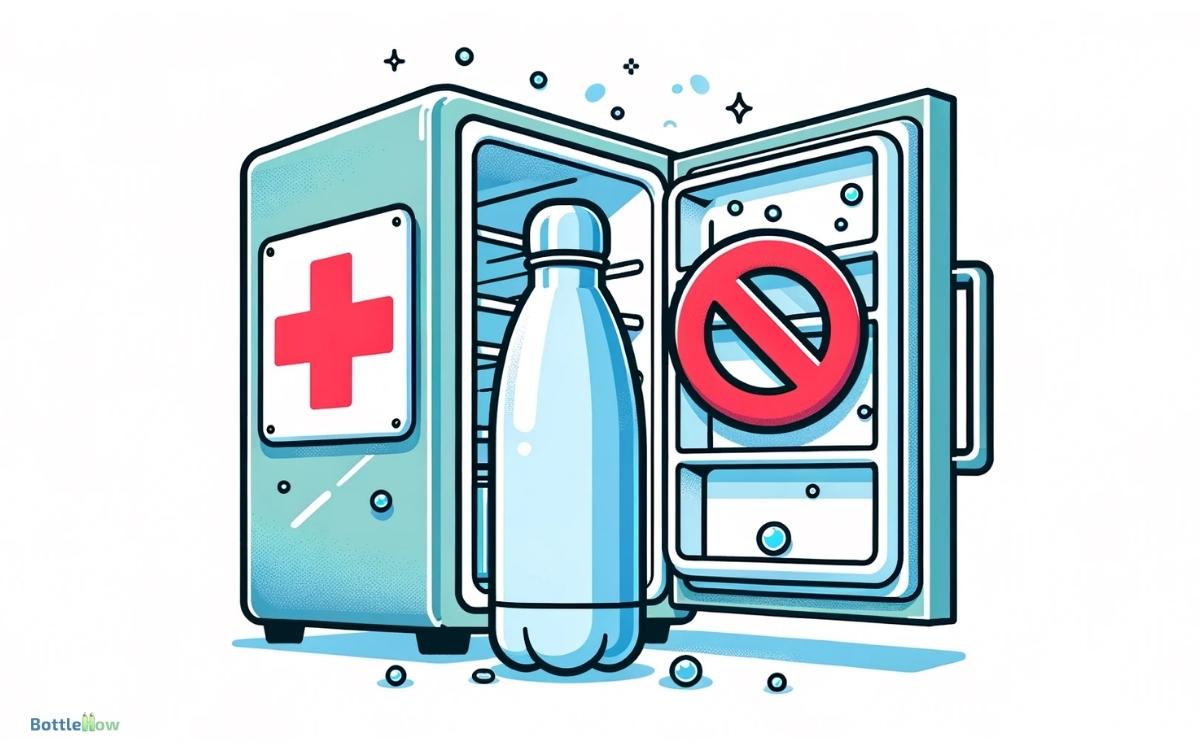Can You Put an Insulated Water Bottle in the Freezer? No!
You shouldn’t put an insulated water bottle in the freezer. Freezing can damage the bottle’s structure, causing cracks, leaks, and compromising the vacuum seal.
The rapid temperature change also degrades insulation performance. Stainless steel can become brittle, and water expansion inside can create fractures.
Following the manufacturer’s guidelines prevents these risks, ensuring longevity and effectiveness. For safer cooling, consider pre-chilling your drink or using ice packs.
Understanding these safety concerns and cooling techniques can help you preserve your bottle’s integrity and function. Keep exploring to learn the best ways to maintain your insulated bottle properly.

Key Takeaways
Understanding Insulated Bottles
Understanding the science behind insulated bottles is essential for evaluating their performance and safety when exposed to extreme temperatures.
These bottles typically consist of a double-wall construction with a vacuum-sealed gap between the walls. This design minimizes heat transfer, keeping your beverages cold or hot for extended periods.
However, the vacuum seal can be vulnerable. If the bottle is subjected to rapid temperature changes, such as placing it in a freezer, the integrity of the seal might be compromised. This could lead to reduced efficiency and potential leakage.
You should also be aware of the materials used in the bottle’s construction. Some metals and plastics can contract or expand under extreme temperatures, posing risks of deformation or breakage. Always follow manufacturer guidelines for safe usage.
Freezer Effects on Insulation
When you place an insulated water bottle in the freezer, its insulation performance can degrade, compromising its ability to maintain internal temperatures.
Additionally, extreme cold can cause potential damage to the bottle’s structure, leading to cracks or leaks.
Be aware that these factors could also result in temperature retention issues, making the bottle less effective overall.
Insulation Performance Degradation
Placing your insulated water bottle in the freezer can compromise its peak performance due to potential damage to the vacuum seal.
When the bottle is subjected to freezing temperatures, the materials can contract, causing stress on the vacuum insulation.
This contraction might lead to minor cracks or even a complete failure of the vacuum seal, reducing the bottle’s insulation capabilities.
Over time, this degradation means your bottle won’t keep beverages as hot or cold as intended. For top-notch performance and longevity, avoid exposing your insulated bottle to extreme cold.
By following these guidelines, you’ll maintain the integrity of the vacuum seal, ensuring your bottle continues to perform effectively.
Always prioritize proper usage to protect your investment.
Potential Bottle Damage
While vacuum seal degradation is a concern, the physical structure of your insulated water bottle itself can also suffer from exposure to freezing temperatures.
When you place an insulated bottle in the freezer, the expanding water inside can cause the inner and outer walls to warp or crack.
This structural damage not only compromises the bottle’s integrity but also its insulating properties.
The thermal stress from cycling between freezing and room temperatures further exacerbates these risks.
To avoid potential damage, refrain from freezing your insulated bottle. Instead, fill it with pre-chilled liquids or use ice cubes.
By doing so, you preserve both the bottle’s physical structure and its ability to keep your drinks at the desired temperature.
Temperature Retention Issues
Freezing an insulated water bottle can severely diminish its ability to retain temperature, as the insulating materials aren’t designed to withstand extreme cold.
When you place the bottle in the freezer, the insulation can contract and lose its effectiveness, leading to reduced thermal retention. This means your drink may not stay as cold—or hot—as you’d anticipate.
Additionally, repeated freezing can cause microfractures in the insulation layer, further compromising its performance.
For safety, avoid placing your insulated bottle in the freezer. Instead, use ice cubes or pre-chill the liquid before adding it to the bottle.
Material Considerations
When placing an insulated water bottle in the freezer, you need to take into account how the material will react to extreme cold.
Insulation performance may degrade, and materials like stainless steel or plastic can expand, potentially causing damage.
Always verify the manufacturer’s guidelines to guarantee safety and maintain the bottle’s integrity.
Insulation Performance Impact
The type of insulation material in your water bottle greatly impacts its performance and durability when placed in the freezer.
Double-walled stainless steel, vacuum insulation, and foam insulation all interact with cold temperatures differently. Stainless steel bottles may not crack but won’t insulate efficiently when frozen.
Vacuum insulation maintains temperature but risks damage from expanding ice. Foam insulation, while affordable, can degrade quickly with repeated freezing.
| Insulation Type | Performance Impact | Durability in Freezer |
|---|---|---|
| Stainless Steel | Low insulation efficiency | High |
| Vacuum Insulation | Good insulation, risk damage | Moderate |
| Foam | Poor insulation | Low |
| Plastic | Moderate insulation | Varies |
| Glass | High risk of breaking | Low |
Understanding these differences will help you assess the suitability of freezing your insulated bottle.
Material Expansion Risks
Placing an insulated water bottle in the freezer can lead to material expansion risks that compromise its structural integrity.
When water freezes, it expands, exerting pressure on the bottle’s walls. If the bottle’s materials aren’t designed to accommodate this expansion, you might face cracks or deformations.
Stainless steel, commonly used in insulated bottles, can become brittle at sub-zero temperatures, increasing the risk of damage.
Additionally, the vacuum seal, essential for insulation, could break under stress, rendering the bottle ineffective.
To avoid these risks, it’s important to follow the manufacturer’s guidelines and avoid freezing your insulated bottle.
Instead, consider refrigerating or using ice cubes to keep your drink cold without jeopardizing the bottle’s integrity.
Risks of Freezing
Freezing your insulated water bottle can cause the material to crack or warp, compromising its structural integrity and insulation properties.
When water expands as it freezes, the pressure exerted on the bottle’s walls can lead to fractures or deformations.
Even minor cracks can greatly reduce the bottle’s ability to maintain temperature, rendering it less effective.
Additionally, these structural issues may escalate over time, leading to leaks or complete failure of the bottle.
Moreover, the vacuum seal, essential for insulation, can be compromised by the extreme cold, diminishing the bottle’s efficiency.
Hence, it’s important to avoid freezing your insulated water bottle to preserve its longevity and performance. Understanding these risks helps you make informed decisions about your bottle’s care.
Safety Concerns
Exposing an insulated water bottle to freezing temperatures can pose significant safety hazards, including potential chemical leaching from compromised materials.
When you place an insulated bottle in the freezer, several risks arise that you should be cognizant of:
- Material Degradation: The extreme cold can cause the bottle’s materials to break down, leading to possible ingestion of harmful substances.
- Seal Integrity: Freezing can compromise the bottle’s vacuum seal, rendering its insulation ineffective and causing leaks.
- Structural Damage: Expansion of liquids during freezing can distort or crack the bottle, creating sharp edges that may injure you.
Understanding these risks is essential for maintaining your safety. Always make sure you’re using your insulated water bottle within the manufacturer’s recommended temperature range to prevent these hazards.
Freezer-Friendly Alternatives
Looking for freezer-friendly alternatives guarantees you stay safe while keeping your drinks cold without compromising your insulated water bottle.
Consider using ice packs or reusable ice cubes. They’re specially designed to stay frozen longer and fit into most bottles.
Another option is pre-chilled water. Fill a non-insulated bottle halfway, freeze it, then top it off with cold water before transferring it to your insulated bottle. This method avoids the risk of damaging the insulation.
You might also explore insulated sleeves designed to hold ice packs, providing an extra layer of cooling.
These alternatives make sure your drink remains cold without exposing your insulated bottle to potential damage from the extreme temperatures and expansion risks within a freezer.
Proper Cooling Techniques
How can you guarantee your drink stays cold while safeguarding the integrity of your insulated water bottle?
There are several effective techniques you can use, all while avoiding the risks associated with freezing.
- Pre-chill your bottle: Fill it with cold water or ice for a few minutes before adding your drink. This prepares the insulation to maintain a lower temperature longer.
- Use ice packs: Instead of risking your bottle in the freezer, place ice packs around it. This method offers a safe, controlled cooling environment.
- Refrigerate the contents: Chill your beverage in a separate container in the fridge, then transfer it to the insulated bottle. This reduces thermal shock and prevents potential damage.
Maintenance Tips
Maintaining your insulated water bottle in top condition means regularly cleaning it and checking for signs of wear and tear.
Use mild soap and a bottle brush to remove any residue. Avoid using the dishwasher unless the manufacturer specifically says it’s safe. Check the bottle’s seals and gaskets for cracks or deterioration.
Here’s a quick maintenance checklist:
| Task | Frequency |
|---|---|
| Clean with mild soap | After each use |
| Inspect seals and gaskets | Monthly |
| Check for rust or damage | Quarterly |
Avoid leaving your bottle in extreme temperatures, as this can damage the insulation. If you notice any unusual odors or discoloration, it may be time for a deeper clean or replacement. Regular maintenance ensures your bottle remains safe and effective.
Brand Warnings
Many brands explicitly warn against placing insulated water bottles in the freezer due to potential damage risks.
You should also consider that ignoring these warnings can void the manufacturer’s warranty. Always check the specific precautions provided by the brand to prevent costly mistakes.
Potential Damage Risks
Placing your insulated water bottle in the freezer can lead to potential damage such as cracking or warping, as often highlighted in brand warnings.
The extreme temperature changes cause the insulated layers to expand and contract, which can compromise the bottle’s structural integrity.
Here are some key risks to bear in mind:
- Cracking: The expansion of liquid inside the bottle can lead to cracks in the inner lining.
- Warping: Repeated freezing and thawing can warp the bottle, affecting its functionality and seal.
- Loss of Insulation: The vacuum-sealed layer might get damaged, reducing the bottle’s ability to maintain temperature.
Understanding these risks can help you make informed decisions and maintain the longevity of your insulated water bottle. Always bear in mind the potential damage before placing it in the freezer.
Manufacturer Precautions
Most manufacturers explicitly warn against placing insulated water bottles in the freezer due to the risk of structural damage and compromised insulation.
Ignoring these guidelines can lead to issues like cracks, warping, or even ruptures. It’s important to heed these warnings to guarantee the longevity and functionality of your bottle.
Here’s a quick comparison of brand-specific warnings:
| Brand | Warning Statement | Risk Level |
|---|---|---|
| Hydro Flask | Do not freeze; may cause insulation to fail. | High |
| Yeti | Not freezer-safe; can lead to deformation. | Moderate to High |
| S’well | Freezing not recommended; potential for cracking. | High |
| Thermos | Avoid freezing; may damage vacuum seal. | Moderate to High |
Following these precautions helps you maintain your bottle’s efficiency and safety.
Warranty Implications
Manufacturers often state that freezing an insulated water bottle can void its warranty, leaving you unprotected against defects and damages.
This is a significant risk, as warranties are your safety net for potential malfunctions. You need to be aware of the specific terms set by each brand.
- Structural Integrity: Freezing can compromise the bottle’s vacuum seal, reducing its insulating effectiveness.
- Material Damage: Extreme temperatures may cause expansion and contraction, leading to cracks or leaks.
- Manufacturer Guidelines: Ignoring brand recommendations can result in complete warranty nullification.
Temperature Limits
Your insulated water bottle‘s temperature limits are crucial to understand before putting it in the freezer.
Most insulated bottles are designed to handle a wide range of temperatures, but extreme cold can compromise their structural integrity.
Manufacturers typically specify a minimum temperature, often around -20°C (-4°F). Exceeding this limit can cause the vacuum seal to fail, diminishing the bottle’s insulating properties. Additionally, the exterior material may crack or warp, leading to potential leaks.
Always check your bottle’s user manual for specific temperature guidelines. Ignoring these limits poses risks not only to the bottle’s performance but also to your safety, as a compromised bottle may not effectively contain liquids.
Prioritize understanding these parameters to ensure optimal use and longevity.
User Experiences
Many users have reported varied experiences when placing their insulated water bottles in the freezer, highlighting both successes and potential pitfalls. Some find it convenient for keeping drinks extra cold, while others warn of potential damage.
Here are key points from user experiences:
Success Stories: Many users successfully use their insulated bottles in the freezer to keep drinks cold for extended periods.
Damage Risks: Insulated bottles can sometimes warp or break due to the expanding liquid and temperature stress.
Safety Concerns: Some users note the risk of the bottle’s contents expanding and causing the bottle to burst, creating a mess and potential hazard.
Understanding these experiences helps you weigh the benefits and risks involved in freezing your insulated water bottle.
Expert Recommendations
Given the mixed user experiences, experts emphasize the importance of following specific guidelines to prevent damage and guarantee safety when placing insulated water bottles in the freezer.
They recommend not filling the bottle completely, as water expands when it freezes, which could compromise the insulation or cause leaks. Make sure the cap is loosely screwed on to allow for expansion.
Here’s a quick reference table:
| Guidelines | Risk Assessment | Expert Tips |
|---|---|---|
| Don’t overfill | Expansion damage | Fill only 3/4 full |
| Loosen the cap | Pressure build-up | Leave space for air |
| Short freezing time | Insulation compromise | Limit to 1-2 hours |
Conclusion
To summarize, placing an insulated water bottle in the freezer isn’t recommended due to potential damage to the bottle and its insulation.
For example, picture putting your high-end insulated bottle in the freezer overnight; the expanding liquid could crack the inner lining, compromising its insulating properties.
Always refer to brand-specific guidelines and follow temperature limits to guarantee safety and longevity. For peak performance, pre-chill your bottle with cold water instead. Avoid sudden temperature changes, as they may damage the bottle’s insulation or exterior. If you’re wondering, can you use boiling water in your bottle, check the manufacturer’s recommendations to prevent warping or leaks. Proper care ensures your bottle remains effective and durable over time.





